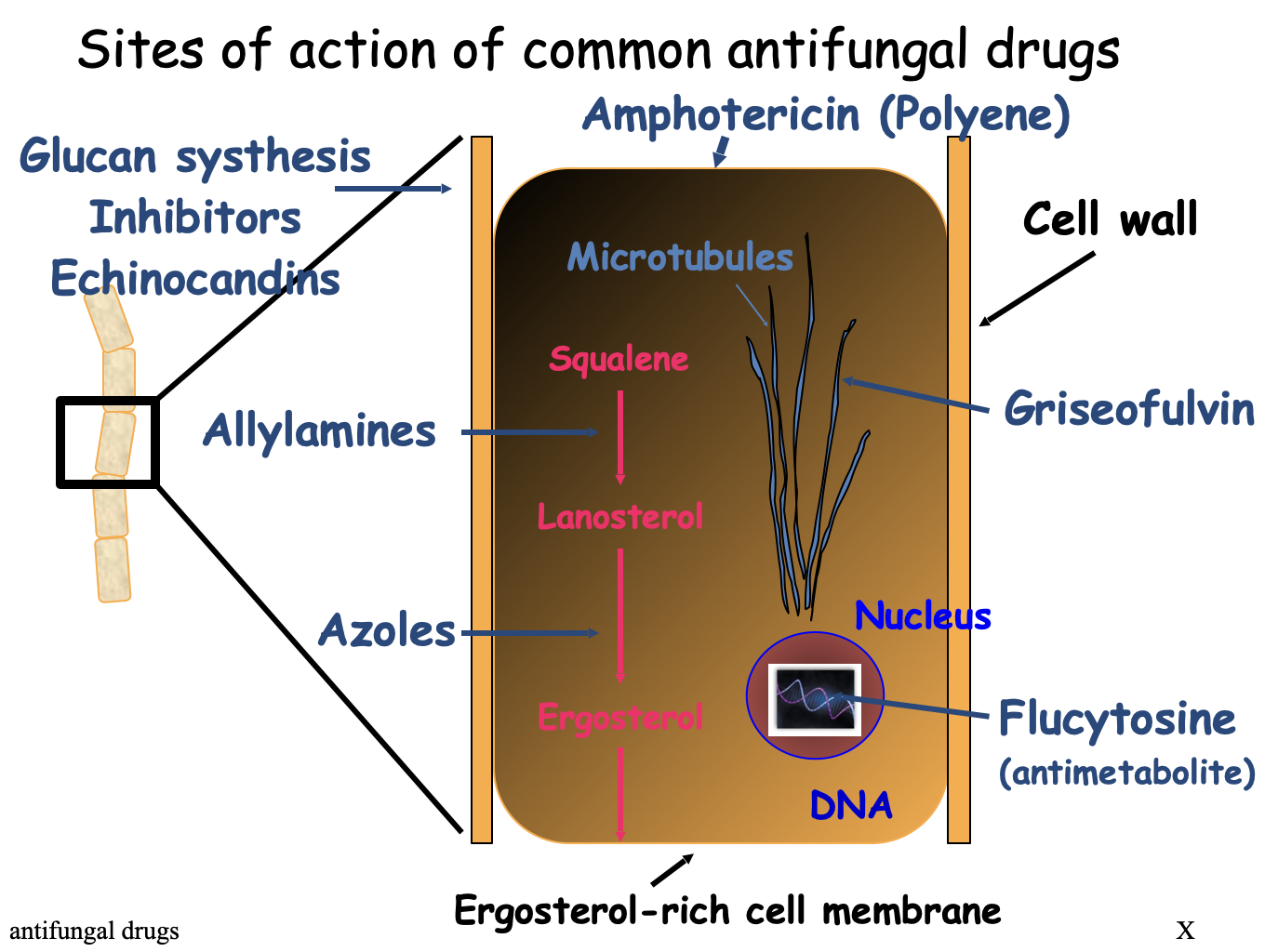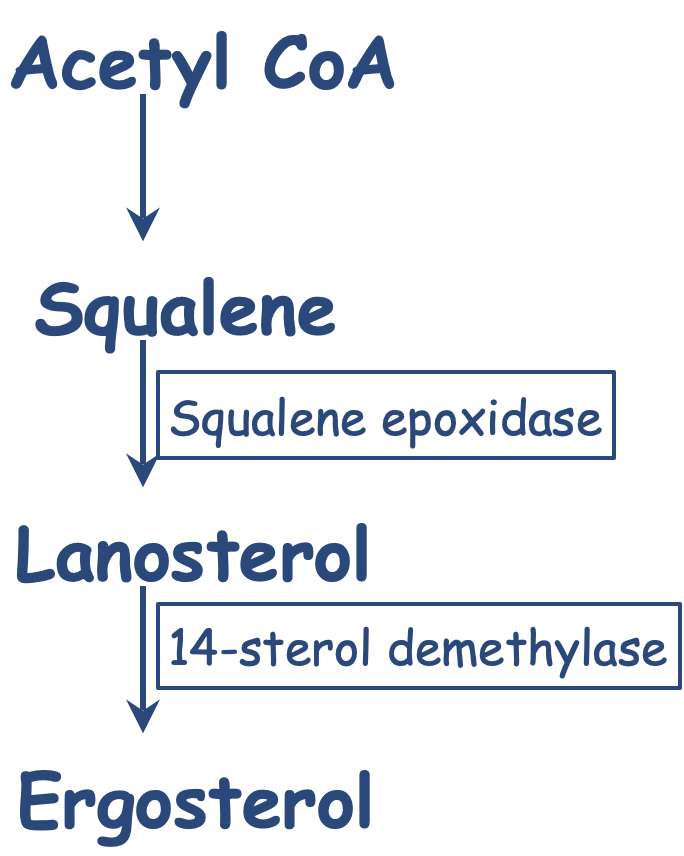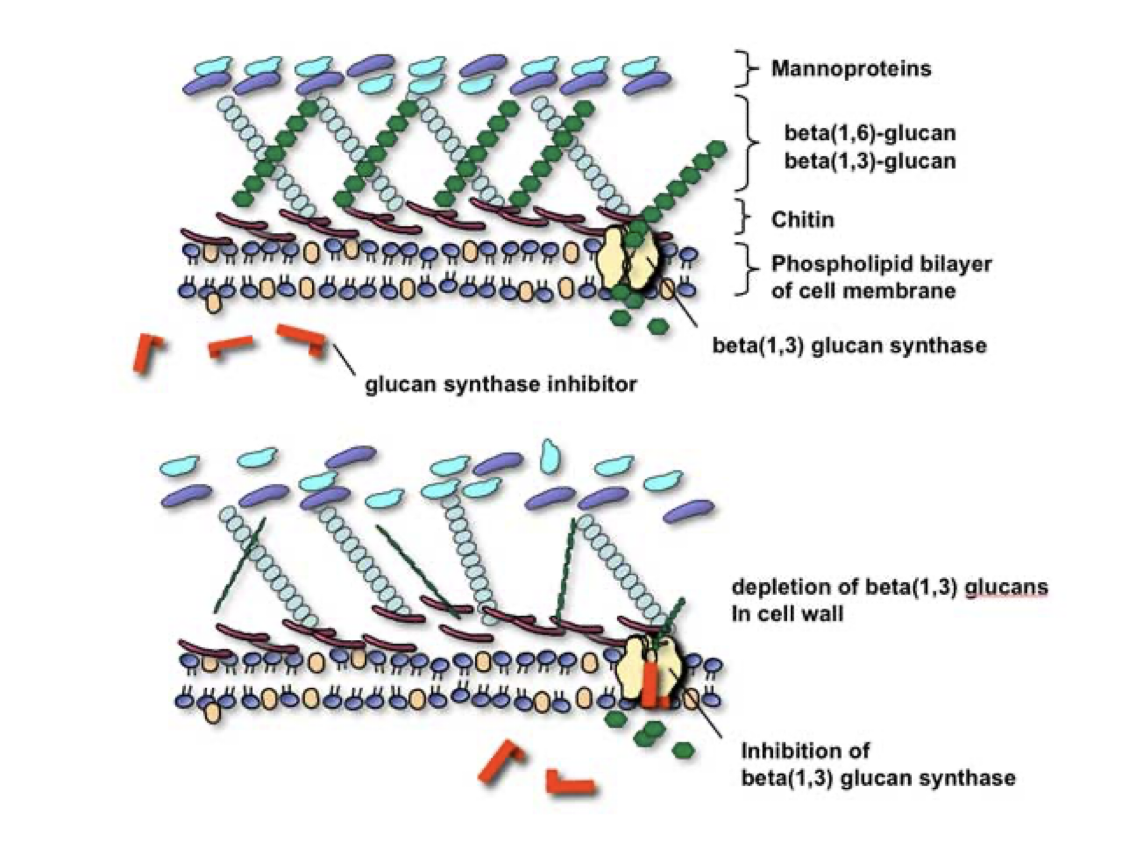Anti-Fungal and Anti-Viral Agents (Week 4, Mod 7)
1/26
There's no tags or description
Looks like no tags are added yet.
Name | Mastery | Learn | Test | Matching | Spaced |
|---|
No study sessions yet.
27 Terms
What are the 5 different classifications that antifungals are classified by?
Superficial/Systemic infection treatment
Topical/Systemic administration of drug
Natural Antifungals/ Synthetic agents
Fungicidal/Fungistatic
Fungicidal = kill; utilized in immunocompromised patients
Fungistatic = stops growth; treats for everything else
Chemical Subclass
What are some reasons why fungal infections may be on the rise?
Use of agents that disrupt normal host microflora - antibiotics
Failure to develop a strong immune system or immunosuppressive drugs
Patient management that suppresses the immune response
Chemotherapy, HIV/AIDS, transplants, steroid treatment
Diabetes
Antibiotic use
Age
Invasive surgical procedures that introduce fungi – iv lines etc; fungus like plastic; can easily create a biofilm
Hospital acquired infection
What are the 6 SUBclasses of chemical antifungals?
Allylamines
Azoles
Polyenes
Glucan Synthesis (cell wall) inhibitors - Echinocandins
Antimetabolites
Griseofulvin - developed at UofG, used for dermatophyte fungal infection of the nail
Very toxic; last resort treatment

What is important for these drugs in particular?
SELECTIVE TOXICITY
Need to target features of the fungus that CANNOT be found in the host
Difficult, due to the fact that fungi are ALSO eukaryotic; need to find a target that is unique to the fungal cell
What is one of the primary (and most common) targets for some of the antifungal agents?
Ergosterol
Like cholesterol but not
Is the main sterol present throughout the fungal cell membrane
Which 3 drug classes target ergosterol in the fungal cell membrane?
Allylamines
Azoles
Amphotericin B (in the class of Polyenes)
MOST COMMON ANTIFUNGAL DRUGS in human and animal medicine
Briefly describe the biosynthesis of ergosterol… what two enzymes are targets for its production?
Enzymes:
Squalene epoxidase
14-sterol demethylase
Lanosterol: precursor molecule

Describe the Allylamines … the mechanism of action, the spectrum of what it targets, side effects, routes of transmission, and pharmacokinetics.
Dermatophyte infections only
Example: Terbinafine (Brand name - Lamisil)
Mechanism of action: inhibits ergosterol biosynthesis via
inhibition of squalene epoxidase (fungicidal)
KILLS fungi; sometimes topical doesn’t work as well, so oral treatment is needed
Spectrum: Dermatophytes
Side effects: generally transient and mild (GIT & skin)
Routes: oral and topical
Pharmacokinetics: highly lipophilic (persists in skin),
Describe the Topical Azoles … the mechanism of action, the spectrum of what it targets, side effects, route(s) of transmission, and pharmacokinetics.
Can be used both TOPICALLY and ORALLY depending on kind of azole…
Imidazoles - Topical use only
Examples: Clotrimazole; Enilconazole, Miconazole - lots of topical azoles – main use is topical for superficial mucous membrane and skin infection
Ketoconazole – oral therapy but toxic; CAN CAUSE LIVER FAILURE
Mechanism of action: inhibition of cytP450-dependent 14-sterol de-methylase
Spectrum: Broad spectrum (generally fungistatic; prolonged treatment)
Side effects: GIT; anorexia; hepatotoxicity; suppression of steroid production (ketoconazole); teratogenic, can cause cancer
Describe the Systemic Azoles … the mechanism of action, the spectrum of what it targets, side effects, route(s) of transmission, and pharmacokinetics.
Triazoles - for serious systemic mycoses
Examples: fluconazole, itraconazole, voriconazole, and posaconazole
Itraconazole – drug of choice for Histoplasmosis
Routes: oral
Itraconazole: lipophilic, highly plasma protein bound, hepatic metabolism and excretion in faeces
Good against aspergillus
Fluconazole: water soluble and can be given i.v, minimally plasma protein bound, minimally metabolised, 80% excreted by kidney unchanged
Good against zygomycetes
Both FUNGICIDAL, as the fungi they target only infect immunocompromised patients
How do fungi eventually develop antifungal resistance to azoles?
Membrane changes lead to reduced drug up-take
Mutation of the target enzyme
Over production of the target enzyme
Modification of the ergosterol biosynthesis pathway
Drug efflux due to up-regulation ABC transporters, MFS transporters
Biofilm formation - can form biofilms in IV lines
Describe the Polyenes … the mechanism of action, the spectrum of what it targets, side effects, route(s) of transmission, and pharmacokinetics.
Examples: Amphotericin B, Nystatin
Mechanism of action: binds to ergosterol, disrupts osmotic integrity of the membrane by forming pores – ions leak from cell – cidal and oxidative (H2O2) damage
Spectrum: broad spectrum
Side effects: nephrotoxicity (i.v.), hypokalaemia, thrombophlebitis
Routes: depends on preparation – Nystatin topical
Pharmacokinetics: poorly water soluble (amphotericin Bs forms a colloid in solution for injection), poor absorption from GIT
** VERY effective against fungi, but also VERY toxic to the patient; lots of side effects
Mainly used in VERY ill patients
What is an example of a nystatin product?
Canaural - topical; for yeast infection
Spectrum of nystatin is broad but
topical version mainly for yeast infection in skin
For otitis externa in dogs and cats
Also contains a drug that kills ear mites and an anti-inflammatory drug.
How do fungi manage to resist Polyenes?
Amphotericin B resistance remains rare
Linked to reduced ergosterol in fungal cell membrane
Forms cross membrane pores - leads to cell leakage and cell death
Resistance linked to increased intracellular catalase reducing the oxidative killing mechanism of AmB.
Innate resistance in some isolates of Candida lusitaniae, Aspergillus terreus, Scedosporium species, Lomentospora prolificans and Purpureocillium lilacinum.
Fungicidal – emergent resistance rare - cells killed not bathed in fungistatic agent allowing mutation resistance – although observed in C. guilliermondii
What is another primary target for antifungals that is unique to fungal cells?
FUNGAL CELL WALL
Main component = glucans
Can inhibit the production of glucans to weaken the cell wall
Inhibit the enzyme beta (1,3) glucan synthase

Describe the Echinocandins (glucan wall inhibitor) … the mechanism of action, the spectrum of what it targets, side effects, route(s) of transmission, and pharmacokinetics.
Severe systemic mycoses only
Examples: Caspofungin; Anidulafungin, Micafungin
Mechanism of action: block synthesis of β (1,3) glucan
Spectrum: Candida & Aspergillus Species
Side effects: minimal
Routes: i.v.
Pharmacokinetics: water soluble, highly plasma protein bound, eliminated in urine and faeces as metabolites
What is the mechanism of RESISTANCE to echinocandins?
Inhibit glucan synthase which synthesizes beta glucan, a structural component of fungal cell walls
Structural integrity lost – cidal in yeast, static in moulds
Many moulds resistant (not Aspergillus) most Candida species susceptible
Candida parapsilosis innately less susceptible – higher breakpoints
Various FKS1 (glucan synthase subunit) mutations identified also FKS2 and 3 genes all of which encode the target enzyme and up-regulation of chitin synthesis - rescue mechanism
Describe the Antimetabolites … the mechanism of action, the spectrum of what it targets, side effects, route(s) of transmission, and pharmacokinetics.
Examples: Flucytosine (5-fluorocytosine – converted to 5-fluorouracil by cytosine deaminase) - Combination therapy for severe yeast infections only
Mechanism of action: Incorporation of 5-FU into RNA disrupts protein synthesis (fungicidal) and further conversion of 5-FU to fluorodeoxyuridine monophosphate inhibits thymidylate synthase which interferes with DNA synthesis (double hit; reduces protein synthesis and fungus replication)
Spectrum: Narrow; Cryptococcus; Candida species
Side effects: generally well tolerated
Routes: oral
Pharmacokinetics: excreted unchanged by kidney
Often combined with Amphotericin B (synergism)
Drug of choice for CRYPTOCOCCUS infection
- Need to treat with flucytosine AND amphotericin B, never Flucytosine on its own; fungus will become resistant to it very rapidly
How do fungi resist flucytosine?
Sensitive – cascade of active enzymes, cytosine permease to take up the drug, cytosine deaminase and phosphorylase to metabolize it to its toxic form – disrupts RNA and DNA synthesis
5-FC converted to 5-FU – Fluorouracil – miscoded RNA or DNA
Loss or reduction in activity in any of the enzymes (but most commonly the phosphorylase) leads to primary emergent resistance
Common during treatment – rarely used as monotherapy, always combined with AmB
Describe the Griseofulvin … the mechanism of action, the spectrum of what it targets, side effects, route(s) of transmission, and pharmacokinetics.
Dermatophyte infections only
Mechanism of action: selectively deposited in newly formed keratin, inhibits mitosis, disorganises the spindle microtubules (fungistatic)
Spectrum: Narrow spectrum (dermatophytes)
Side effects: idiosyncratic reaction (unexpected side effects, cannot be predicted) in cats, teratogenic (can’t give to pregnant animals)
Routes: Oral (with high fat diet)
Pharmacokinetics: Poorly water soluble, hepatic metabolism and faecal elimination
Note: No longer licenced for food producing animals in UK. Only horses. **
What are some other agents that can be used as antifungals? What are their mechanisms?
Iodides – may enhance the immune response of the host
Propionic, salicylic and undecanoic acids
Whitfield’s ointment: benzoic acid and salicylic acid in an emulsifying base) have been used traditionally for treating dermatophyte infections of the skin. Though old-fashioned and a little messy, they are cheap and effective.
Phenolic antiseptics
e.g. thymol
Hexachlophene
What is an example of a medication that has a combination of antifungal, antibacterial, and steroid?
Aurizon - a medication for ear infections
Contains:
Marbofloxacin (antibacterial)
Clotrimazole (antifungal)
Dexamethasone (steroid)
What are the 5 antiviral agents that are mentioned in this lecture, and what are they used to treat?
1) Aciclovir - targets herpes simplex
2) Amantadine and Rimantadine - treat Influenza A
3) AZT - treats retroviruses
4) Tamiflu - targets Influenza A and B
Describe Aciclovir and its mechanism of action, how its administered, side effects, etc.
Aciclovir – nucleoside analogue – substrate for HSV thymidine kinase – phosphorylated only in HSV infected cells to form acyclovir triphosphate, a competitive inhibitor of viral DNA polymerase – stops viral replication
Inhibits viral DNA polymerase
High specificity for herpes simplex
oral, iv, topical – wide distribution
minimal side effects
Uses FHV, viral eye infection
Describe Amantadine and Rimantadine and its mechanism of action, how its administered, side effects, etc.
Blocks viral M2 ion channel
Influenza A
oral – well absorbed
minimal side effects
high rates of resistance in Influenza A viruses
Describe Zidovudine (AZT) and its mechanism of action, how its administered, side effects, etc.
Looks like thymidine – a nucleoside - NRTI Viral RT makes a DNA copy of viral RNA genome – inserts into host chromosome – host enzymes phosphorylate the drug to triphosphate form – inhibits viral replication through competitive binding to viral RT – terminates DNA chain elongation
nucleoside reverse transcriptase inhibitor
retroviruses
oral, iv.
short term: minor reversible side effects
long term: anaemia, GIT disturbances
FLV and FIV
Describe Zanamivir (Relenza) and Oseltamivir (Tamiflu) and its mechanism of action, how its administered, side effects, etc.
Treatment and prophylaxis of Influenza A and B
Neuraminidase inhibitor; stops new viruses emerging
Recently used against H1N1 and H5N1
Also active against canine parvovirus, feline panleukopenia, kennel cough, and ‘canine flu’.